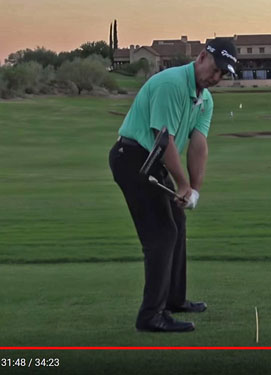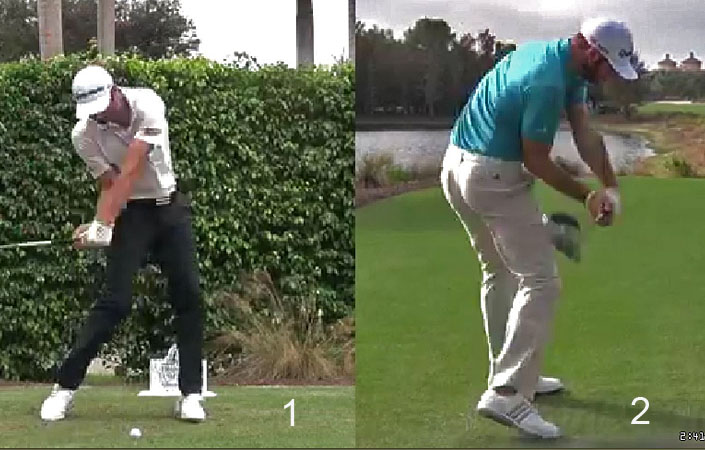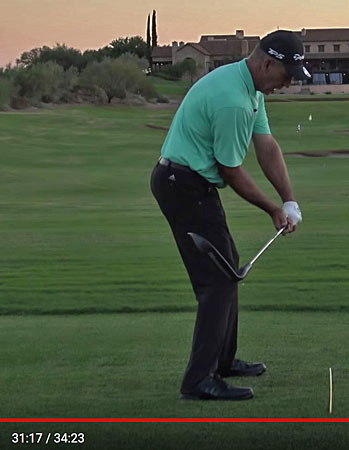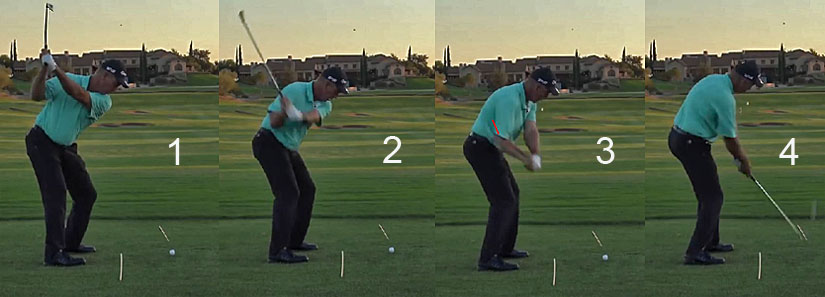Here is further evidence that demonstrates that what Mike Malaska teaches with respect to his "Malaska Move" has no relevance to a "real life" golf swing.
Here again is the video produced by Brendon DeVore.
Here are capture images from the video where Mike Malaska demonstrates the "Malaska Move".
Image 1 shows Mike Malaska using a shortened backswing action.
Image 2 shows him starting to perform the "Malaska Move" where he drops his hands down to a point just outside his right thigh and where his hands are very close to his body and behind the toe line.
Image 3 shows how he swings the clubhead over his hands to get the clubhead outside his hands - using a "tumble action" (clubshaft steepening action). Note that his right palm is partially on top of the club handle. Note that his clubshaft is not parallel to the ball-target line. Note that the clubface is tilted forward and that it is slightly closed to the clubhead arc.
Throughout the video, you can see Brendon DeVore repeatedly performing the same "Malaska Move" maneuver, where he gets his right palm on top of the club handle at P5.5. and where the clubshaft has "tumbled" so that it is over-the-plane (clubhead is closer to the ball-target line than his hands) thereby producing an out-to-in clubhead path through impact.
The irony is that Mike Malaska does not use the "Malaska Move" in his "real life" golf swing when he takes a full golf swing. Mike Malaska episodically performs a full golf swing action in the video where he hits a ball, and here are capture images from one of the full golf swing actions.
Image 1 shows his shortened backswing action.
Image 2 shows Mike Malaska at the P5.5 position. Note that he has shallowed the clubshaft between image 1 and image 2. Note that his right palm is under the club handle. Note that his hands are not moving downwards to a position alongside his right thigh and that they are moving more outwards in the direction of the ball-target line.
Image 3 is just passed the P6 position. Note that his right palm is still partially under the club handle. Note that his hands are ahead of his toe line and he is not pulling the butt end of the club handle inwards towards his body. Note that his clubface is open, and not closed, to the clubhead arc. Note that he is releasing PA#2 and that the released clubshaft is tracking under his hands, and not over his hands.
From that standard P6 position, he obviously has to use a PA#3 release action (which combines left forearm supination + right forearm pronation) in order to get a square clubface by impact.
At the 22:00 minute time point of the video, Mike Malaska demonstrates three swing actions where he swings the club around his body in a circular manner - and he asks Brendon DeVore which of the three swing actions is the "best" swing action. Brendon obviously chooses swing action number 1.
Here are capture images of swing action number 1.
Image 1 is his end-backswing position. Note that his right palm is under the club handle.
Image 2 is at roughly the P5.5 position and image 3 is at the P6 position. Note that his right palm is under the club handle and that his right forearm is markedly supinated and that the back of his left hand faces the sky because his left forearm is significantly pronated.
Image 4 is at impact. Note that the back of his left hand must be facing the target and his right palm is facing the target. It is obvious that he must have used a PA#3 release action between P6 and impact to get a square clubface at impact - and that means that he must be supinating his left forearm and pronating his right forearm in the standard manner.
After demonstrating this swing action in a "baseball swing" manner, he then bends over and hits a "friggin golf ball".
Here are capture images of his swing action when he performs that full golf swing action.
Image 1 is at his end-backswing position.
Image 2 is at the P5 position.
Image 3 is at the P5.5 position. I have drawn a red line parallel to his clubface to show that it is wide open. Note how much he has shallowed the clubshaft between image 2 and image 3. Note that his right palm is under the club handle and his hands are ahead of his toe line.
Image 4 is just passed impact where the back of his left hand and right palm are facing the target.
It is obvious that Mike Malaska must be using a standard PA#3 release action (which combines left forearm supination + right forearm pronation) between P6 and impact in order to square the clubface by impact.
Mike Malaska is using the "standard" golf swing action in his "real life" golf swing action and there is no evidence of any clubshaft-steepening (clubshaft standing-up) phenomenon in his early-mid downswing and no evidence of the "Malaska Move" pivot motion where the right palm gets on top of the club handle and where the clubshaft moves over the hands.
Jeff.










